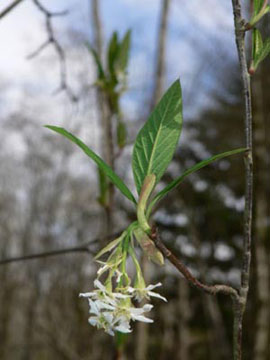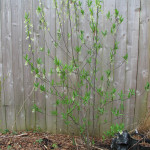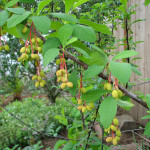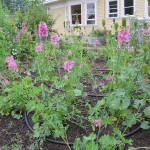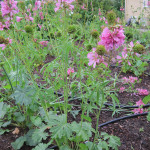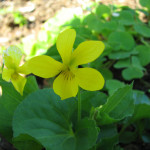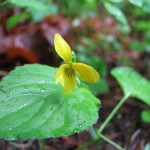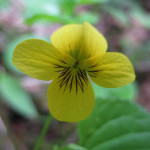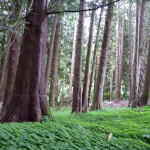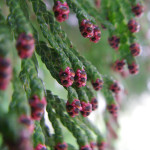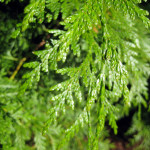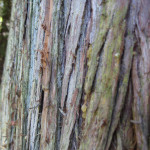Oemleria cerasiformis
Osoberry is a fast-growing, multi-stemmed shrub to small tree with reddish to purplish-brown bark. In open sunny locations it may form a dense shrub, while in the shade it becomes more open to sprawling. This is one of our earliest flowering native shrubs, and its slender, lime-green leaves are one of the first signs that spring is on the way!
This woodland plant does best in moist areas with dappled shade, and can tolerate many soil types, including heavy clay.
In the early spring, both male and female osoberries produce dangling clumps of whitish flowers. Female plants will then produce small hard berries towards the end of summer (male plants produce no fruit). The fruit is peach-colored early in the season, maturing to blue-black in the fall, and is a favorite of many birds and small mammals. Osoberry also serves as a host for several caterpillar species, and the flowers are a source of nectar for butterflies, hummingbirds, and pollinators, making this an excellent wildlife plant.
- Light Requirements: Full Sun, Part Shade, Full Shade
- Water Requirements: Dry, Moist
- Ease of Growing: Easy to grow
- Growth Rate: Fast
- Spreads: No
- Wildlife Support: Birds or Mammals
- Fire-resistant: Yes
- Edible: Yes
- Mature Height: 15ft
- Mature Width:5-10ft
Cusick’s Checkermallow
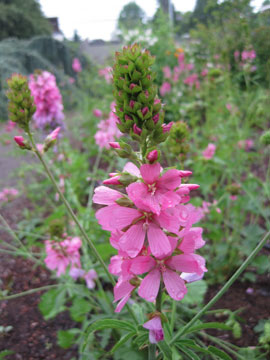
Sidalcea cusickii
A delightful, hollyhock-like perennial rarely found outside its native Oregon, and not in every county. Stands of this perennial have been reported in Washington, Multnomah, Yamhill, Benton, Linn, Lane, Douglas, Coos and Jackson counties, but not all are documented.
- Light Requirements: Full Sun, Part Shade
- Water Requirements: Dry, Moist
- Ease of Growing: Easy to grow
- Growth Rate: Fast
- Spreads:
- Wildlife Support: Pollinators, Birds or Mammals
- Fire-resistant: No
- Edible: Yes
- Mature Height: 4ft
- Mature Width:2ft
Lady Fern
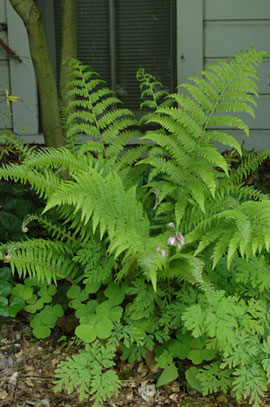
Athyrium filix-femina
Athyrium filix-femina (Lady Fern or Common Lady-fern) is a large, feathery species of fern native throughout most of the temperate Northern Hemisphere, where it is often abundant (one of the more common ferns) in damp, shady woodland environments and is often grown for decoration in shady home gardens.
- Light Requirements: Full Sun, Part Shade, Full Shade
- Water Requirements: Moist, Seasonally Wet
- Ease of Growing: Easy to grow
- Growth Rate: Moderate
- Spreads: No
- Wildlife Support: Hummingbirds, Birds or Mammals
- Fire-resistant: No
- Edible: No
- Mature Height: 4ft
- Mature Width:2ft
Wood Strawberry

Fragaria vesca ssp. bracteata
After flowering, rounded, egg-shaped, red edible berries appear in the late summer and early autumn. These appear to be smooth coated but are in fact covered in very short hairs, visible only at close range.
- Light Requirements: Full Sun, Part Shade
- Water Requirements: Dry, Moist
- Ease of Growing: Easy to grow
- Growth Rate: Moderate
- Spreads: Yes
- Wildlife Support: Birds or Mammals
- Fire-resistant: Yes
- Edible: Yes
- Mature Height: 6in
- Mature Width:1ft
Yellow Wood Violet
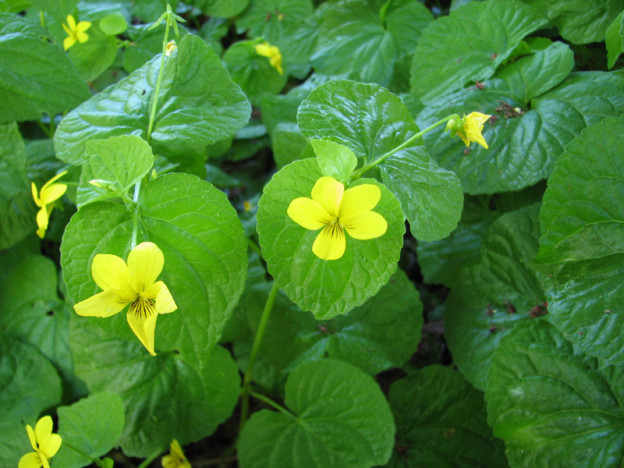
Viola glabella
Yellow wood violets have large, bright-green, heart-shaped basal leaves just below deep-yellow, pansy-like flowers. The lateral and lower petals are marked with purple veins. Slender leaning or erect stems with leaves only in upper one-third, and bilaterally symmetrical, yellow flowers facing outward, hanging from slender stalks.
A very common species in moist, shaded places in woods. Most western Violets have yellow rather than purple corollas, but all have the perky little flower with a spur or pouch behind the lower petal. The lower petal forms a landing platform for insects seeking nectar within the spur.
- Light Requirements: Part Shade, Full Shade
- Water Requirements: Moist, Seasonally Wet
- Ease of Growing: Easy to grow
- Growth Rate: Fast
- Spreads: Yes
- Wildlife Support: Pest-eating Insects, Birds or Mammals
- Fire-resistant: No
- Edible: Yes
- Mature Height: 4-9in
- Mature Width:6-12in
Western Redcedar
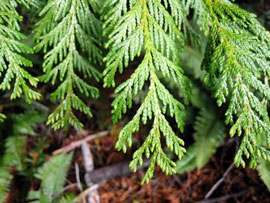
Thuja plicata
Western redcedar (Thuja plicata) is a large evergreen conifer treasured not only for its beauty, but also its wildlife value and cultural significance going back to time immemorial.
Mature Western redcedars can get 115 – 230 feet tall. The flat, elegant sprays of foliage makes the tree look like it is draped with lace, especially when dusted with frost or snow. The cones are slender with overlapping scales. This tree is actually part of the cypress family, and not a true cedar (just like Douglas-fir is not a true fir).
Western redcedars make excellent wildlife habitat, providing food and shelter for many species. Rosners hairstreak butterflies are only found in association with this tree, as they depend on it for reproduction and food for their young. Large and small mammals feed on the leaves and inner bark for most of the year; squirrels and other rodents use its shredded bark for winter nests; and many birds and small mammals find shelter and nest sites in red cedar cavities.
Western redcedar is a iconic tree of the Pacific Northwest. If you have a shady, moist spot large enough for it to thrive, this is a beautiful and valuable addition to any forested landscape.
- Light Requirements: Full Sun, Part Shade, Full Shade
- Water Requirements: Moist, Seasonally Wet
- Ease of Growing: Easy to grow
- Growth Rate: Moderate
- Spreads: No
- Wildlife Support: Birds or Mammals
- Fire-resistant: No
- Edible: No
- Mature Height: 100-200ft
- Mature Width:30ft
Oregon White Oak
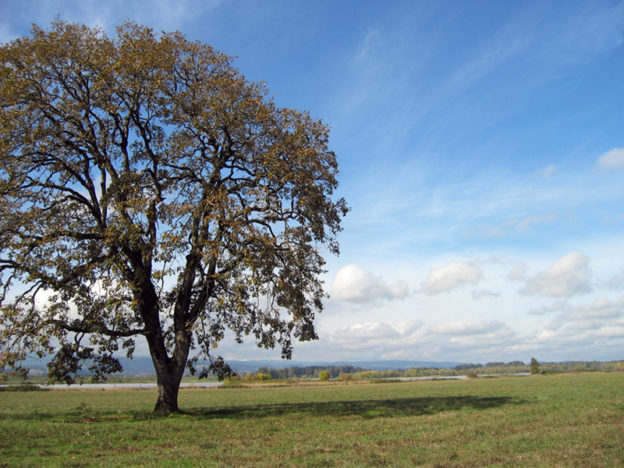
Quercus garryana
The iconic Quercus garryana, also known as Garry oak and Oregon white oak, is a drought tolerant tree that can also tolerate prolonged seasonal flooding. It can often grow on sites that are too dry for other tree species. These slow-growing trees are smaller at maturity than many Pacific Northwest trees, growing eventually to a maximum size of 65-80 ft tall and wide. They have deep tap roots and widely spreading roots, making them resistant to wind-throw. Mature trees growing in open areas develop broad oval crowns, making them excellent shade trees.
The leaves are deciduous, 3-6″ long and 2-5″ broad, with 7-9 deep lobes on each side. The flowers are catkins, and the fruits are small acorns about 1″ long with shallow, scaly cups.
Over 200 species of wildlife benefit from Oregon white oaks, including pollinators such as Fender’s blue, Taylor’s checkerspot, Mardon skipper, Islad marble, and the Oregon silverspot. The Oregon white oak is also the only known food for the caterpillars of Propertius duskywing butterflies and a leaf-mining moth. Deer, bear, raccoons, squirrels, and many small mammals eat the acorns, as do wild turkeys, band-tailed pigeons, woodpeckers, jays, and others.
Oregon white oaks also have significant cultural value for many Native tribes. For all these reasons, Oregon white oaks and their associated prairie habitats are the focus of many regional conservation efforts.
- Oregon white oak (Quercus garryana) has thick, fire-resistant bark. Younger trees are more vulnerable.
- Light Requirements: Full Sun
- Water Requirements: Dry, Moist
- Ease of Growing: Moderate
- Growth Rate: Slow
- Spreads: No
- Wildlife Support: Pest-eating Insects, Birds or Mammals
- Fire-resistant: Yes
- Edible: No
- Mature Height: 25-70ft
- Mature Width:30-60ft
Blue Elderberry

Sambucus cerulea
Blue elderberry (Sambucus cerulea) is a large, fast-growing deciduous shrub or small tree featuring showy clusters of creamy-white flowers that mature into large clusters of blue-black berries.
This shrub is a great addition to your wildlife garden. Many birds eat the berries, and butterflies visit the flowers for nectar. The plant provides food for the young of spring azure butterflies and various moths. Native solitary bees shelter and lay their eggs in the hollow twigs. Dead elder wood is also the preferred habitat of the mushroom Auricularia auricula-judae, also known as Judas’ ear fungus or wood ear fungus.
Blue elderberry can get quite tall, reaching up to 15 feet in height. Plant it in sun to part shade in well drained soils.
- Light Requirements: Full Sun, Part Shade
- Water Requirements: Dry, Moist
- Ease of Growing: Easy to grow
- Growth Rate: Fast
- Spreads: No
- Wildlife Support: Pollinators, Pest-eating Insects, Birds or Mammals
- Fire-resistant: Yes
- Edible: Yes, but parts of the plant toxic
- Mature Height: 10-25ft
- Mature Width:18ft

